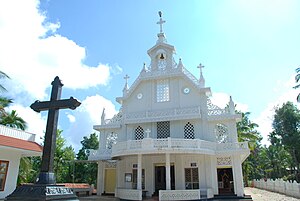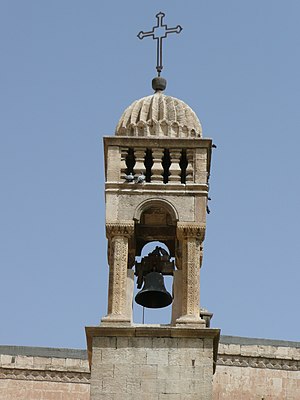- Image via Wikipedia
The Name of the Church
The Syrian Orthodox Church of Antioch is also referred to today as the Syriac Orthodox Church of Antioch.
Historical Origins
The Patriarchate of Antioch claims the greatest antiquity of all the churches of Christendom. Acts 11:26 confirms that the disciples were first called Christians in Antioch. According to tradition, St. Peter established the See of Antioch, presiding over it prior to his departure for the West. The Patriarchate of Antioch held ecclesiastical authority over all the territory between the Mediterranean Sea and the Persian Gulf, a jurisdiction confirmed by both the Council of Nicea (325) and the Council of Constantinople (381). Later, this authority was extended even as far as India and China through the church’s missionary endeavors.
Major Turning Points in History
Around the beginning of the fourth century, the Catholicate of the East was established at Seleucia-Ctesiphon, comprising the bishoprics within the Persian Empire and Mesopotamia. The Catholicate eventually fell victim to Persian political persecution. In 628, a new Catholicate was established in Mesopotamia by Patriarch Athanasius I and was soon expanded to include all Arabia, Persia and Afghanistan. It lasted until 1859. In 1964 Patriarch Ignatius Yacoub III approved the establishment of the Catholicate of the East in India.
The Syrian Orthodox Church of Antioch participated and accepts the Ecumenical Councils of Nicea (325), Constantinople (381), and Ephesus (431), but rejected the decisions of the Council of Chalcedon (451), specifically concerning its interpretation of the two natures of Christ. Due to this, and to political oppression, the Syrian Orthodox Church of Antioch was to undergo many persecutions and hardships.
In 518, Patriarch Severus was forced into exile and established his residence in Egypt, where he labored to keep the Syrian Church of Antioch alive. By 544, only three bishops remained free to serve the needs of the church. During this critical period, a dedicated monk, Jacob Baradaeus, won the support and protection of Empress Theodora, was consecrated as a general metropolitan by Patriarch Theodosius of Alexandria, and was authorized to restore the persecuted churches of the Patriarchates of Antioch and Alexandria. Assisted by three fellow bishops, Mor Jacob visited the faithful throughout the entire Middle East, Asia Minor, and even Ethiopia, rebuilding and expanding the church. Tradition states he ordained over 100,000 priests, 27 bishops, and one Patriarch of Antioch, Paul II. Due to Mor Jacob’s efforts, the Syrian Orthodox Church is often referred to as the Syrian “Jacobite” Church.
On the eve of the Moslem conquest, the Syrian Orthodox Church of Antioch was once again a victim of Byzantine persecution. Constantinople recognized only the Byzantine (Melkite) Patriarch of Antioch. The early years of Moslem occupation were characterized by religious tolerance and justice, and the Syrian Orthodox enjoyed positions of great influence and prestige under the caliphs. During this period, the Arabs were to profit from the culture and learning of the Syrian Church of Antioch.
Following the Crusades, religious toleration gave way to alienation and open persecution.
This situation was further aggravated by the Mongol invasions. The coming of Timur Lane was to spell slaughter and devastation for the Syrian Orthodox Church.
In 1236, the Syrian Orthodox Church of Antioch numbered about 20,000 parishes, not to mention hundreds of monasteries and convents. The church also had great educational and cultural institutions, including the famous schools of Antioch, Nusaybin, and Edessa, and eminent scholars. The tragedies and difficulties already mentioned were to bring an end, however, to the growth and cultural achievements of the Syrian Church.
The situation was further aggravated in the following years by divisions resulting from missionary endeavors, first by the Roman Catholic and later by Protestant missionaries.
The coming of the First World War was to bring renewed persecution in Ottoman Turkey, with large numbers of Syrian Orthodox being forced to flee as refugees into various parts of the Arab Middle East. An estimated quarter of a million faithful were massacred during this period, chiefly at the hands of the Kurds.
- Image via Wikipedia
The Syrian Orthodox Church of Antioch became a member of the World Council of Churches in 1961 and the National Council of Churches of the Christ in the U.S.A. in 1960. The Church is also an active member of the Middle East Council of Churches.
In 1980, His Holiness Moran Mor Ignatius Zakka I was elected as 122nd Patriarch of Antioch and All the East and Supreme Head of the Universal Syrian Orthodox Church.
In their Common Declaration of 1984, Pope John Paul II and Patriarch Ignatius Zakka I, among other things, considered their two churches so close as to even envisage cooperation in pastoral care, including some sacramental sharing.
In 1991, an agreement was reached between the Syrian Orthodox Church of Antioch and the Greek Orthodox Patriarchal See of Antioch that both churches share one common faith and that all efforts must be made to manifest in reality the oneness of the Holy Church of Antioch. Respect for the liturgical and pastoral traditions of both churches was proclaimed.




